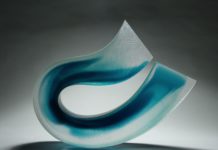Thewa jeweled objects that are created by fusing filigreed gold sheets with glass are crafted by members of the Soni Hindu jeweller caste in Pratapgarh, Rajasthan and Rampura, Madhya Pradesh. Their art can be traced back to over 400 years when a land grant was given by the then ruler Prince Bika to settle the families in the small fortified town of Pratapgarh. The technique of this ancestral craft, now practiced by just a handful of the family, remains a closely guarded secret. Such is the secrecy involved that daughters are not taught the craft in fear that they will carry their knowledge to their in-laws homes and the technique thus pass on to others.
 Using over 18 jewelers tools from hammers, cutters, pliers, burners and engravers, the revealed aspects of the technique include the process of cutting of the gold leaf to size and the crafting of the lace-like filigree. Red, green, black or blue glass plaques form the base material, which is encased in gold backed wire frame. The filigree gold sheet is then gently heated and fused on to the glass surface. “Overheating”, explains Ganpat Soni, a National Award winner and Thewa master “can break the glass or melt the gold. Alternatively, if not treated properly the gold filigree does not fuse well and soon comes off”.
Using over 18 jewelers tools from hammers, cutters, pliers, burners and engravers, the revealed aspects of the technique include the process of cutting of the gold leaf to size and the crafting of the lace-like filigree. Red, green, black or blue glass plaques form the base material, which is encased in gold backed wire frame. The filigree gold sheet is then gently heated and fused on to the glass surface. “Overheating”, explains Ganpat Soni, a National Award winner and Thewa master “can break the glass or melt the gold. Alternatively, if not treated properly the gold filigree does not fuse well and soon comes off”.
Jewelry, boxes, plates, photo frames, perfume bottles and vases are crafted. The filigreed patterns remain traditional, depicting Hindu mythology, Mughal courtly scenes and battlefield pictures. Floral patterns, birds, elephants, deer, lions and other animals are also filigreed. With some of the finest examples of the craft to be seen with collectors and in museums in India and abroad.





